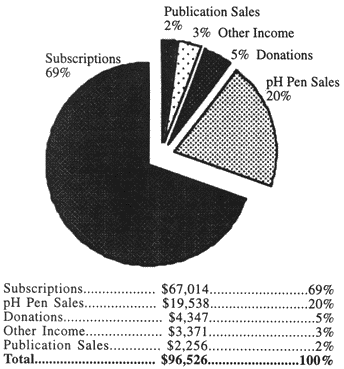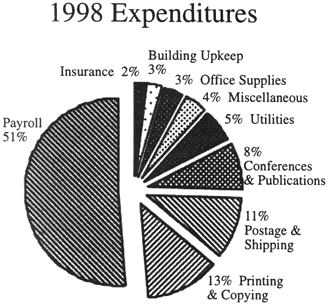


The editor and trustees of Abbey Publications, Inc., a nonprofit corporation, are grateful for the support received from the people and organizations listed below, as well as from those who gave smaller amounts, especially since the Newsletter is an independent publication.
During 1998 we received $3,628; in 1999 we have received $4890. Donations for the current year are listed below for Sponsors ($500-$999), Patrons ($100-$499), and Contributors ($25-$99).
This is all welcome help, because the subscription count has been edging down in the last two or three years, probably because of domestic libraries' need to cut down on serials cost. On the other hand, overseas subscriptions have grown, and now number 191, which is 18% of the total.
Ellen McCrady, Editor
Terry O. Norris
Isamu Sakamoto
Bette Abeel
Bark Frameworks
Ernst Becker
John Boral
Brown's River Bindery
Sally Buchanan
Margaret S. Child
Elizabeth S. Banks
Maire and David La Touche
Mekatronics, Inc.
Metal Edge, Inc.
Tawny Ryan Nelb
New York Community Trust (J. Talcott Fund)
Ocker & Trapp Library Bindery
Marcia Oliver (in memory of Catherine Stanescu)
Preservation Source
Nancy Russell
Nancy Carlson Schrock
Waters - Custom Mfg.
Duane Watson
Baldwin's Book Conservation Service
Julie Biggs
Betsy Palmer Eldridge
Dr. Robert L. Feller
Walter R. Font
Frames of Mind
Carolyn Jane Gammon
Mary Todd Glaser
Maria Grandinette
Patricia Grey
Margaret H. Johnson
Hilary A. Kaplan
Jeanne F. Lewisohn
Kathleen A. Ludwig
Gerald Lundeen
Neschen Corporation
Sandra Nyberg
Cynthia Ostroff
Abigail Quandt
Jeff Rigby
Martha M. Smith
Nathan Stolow
Ann Swartzell
Tamara Swora-Gober
Thomas O. Taylor
Hariklia Tziamtzi
Deborah J. Wender
William Minter Bookbinding
| Year | Vol. | Nos. | |
| AN | 1975-78 | 1 | 1-4, 7, 15 |
| 1981 | 5 | 6 | |
| 1982-97 | 6-21 | Complete | |
| 1998 | 22 | 1-6 | |
| APA | 1987-97 | 1 - 10 | Complete |
Updated 7/99
These are the back issues of the Abbey Newsletter and the Alkaline Paper Advocate on our Web page in CoOL (http://palimpsest.stanford.edu/byorg/abbey/). The list of "Useful Addresses" for 1998 is there too.
A volume is judged to be "complete" in CoOL when the longer features of each issue (e.g., articles) are posted.


Authors of articles and other contributions accepted for publication in the Abbey Newsletter will be assumed (unless they notify the editor otherwise) to be granting permission to publish their work in both print and electronic form, and to archive it and make it retrievable electronically. Authors retain copyright, however, and may republish their work in any way they wish.
Similarly with previous publishers of material who have given permission for their copyrighted material to be published in the Abbey Newsletter , the permission will be assumed to cover the electronic as well as the printed form.
This policy has been adopted for two reasons: 1) It helps the cause of preservation of library and archive materials, and 2) Existing copyright law considers electronic reprints to be merely extra copies of the original publication, in another format.
The Abbey Newsletter: Preservation of Library & Archival Materials is issued eight times a year and has about 1040 subscribers. All subscriptions are for the calendar year. Checks or international money orders may be made out in U.S. dollars, payable to Abbey Publications; send to 7105 Geneva Dr., Austin, TX 78723, USA. Foreign checks must have the name of a U.S. bank printed on the front. International payments can be made by VISA or MasterCard.
Personal subscriptions are $45; institutional subscriptions are $55, and subscriptions for full-time students and unpaid interns $23. Overseas air mail is $15/year.
Paid advertisements, except for job ads, are not accepted. Job advertisements are billed at the rate of $50 for the heading and the first ten lines (50-55 characters per line), plus $2 per line thereafter. Any notice that is appropriate and newsworthy will be printed if there is room for it. Claims for issues never received will be honored within a year of publication.
The Abbey Newsletter is selectively indexed in Art & Archae-ology Technical Abstracts, and the Institute of Paper Science & Technology Abstract Bulletin. All issues are in print, and each volume has its own index. It is the policy of Abbey Publications to use permanent paper for all publications.
The Editor encourages readers to photocopy freely from the Newsletter; but the Editor's permission must be obtained before making more than 20 copies at a time of lengthy or signed articles. This lets us make any necessary corrections or updates, or contact other copyright holders for permission to reprint.
Most back issues from 1981 onward are on our Web page in CoOL <http://palimpsest.stanford.edu/byorg/abbey>.
Abbey Publications is a nonprofit corporation set up to encourage preservation of written or recorded information, including the use of lasting materials in the creation of records. The corporation has five trustees (Ellen McCrady, Gary Frost, Roberta Pilette, James Wellvang, and Thomas Clareson), and five officers (President Ellen McCrady; first vice president Gary Frost; second vice president Jim Wellvang; secretary Tom Clareson; and treasurer Paul Banks).
| Editor: Ellen McCrady | �1999 Abbey Publications, Inc. |
| Circulation Manager: Elizabeth Ray | Phone: 512/929-3992 |
| ISSN: 0276-8291 | Fax: 512/929-3995 |
| Tax ID No. 87-0436104 | E-mail: Abbeypub@flash.net |
Bernard G. Middleton, The Restoration of Leather Bindings. 200 x 250 mm, hard cover with illus dustwrapper. 200 pp of text, profusely illustrated. Published by Oak Knoll Press and the British Library. Third edition, 1998. ISBN 1-884718-50-7. Orders to Oak Knoll Books, 308 Delaware St., New Castle, DE 19720. $35.00 plus shipping.
Reviewed by June McNicolReprinted with permission from Morocco Bound, v.20 #1, March 1999, p. 8. Morocco Bound is the journal of Australian Craft Bookbinders.
When I was first learning the art of book binding, I came across a copy of Bernard Middleton's 1972 edition of The Restoration of Leather Bindings and was immediately entranced. The limpid prose, the beautiful diagrams by Aldren Watson, another binder, and the text which seemed to embrace every possible problem I could be faced with, all in an A4 limp paperback made me decide instantly that bookbinding was for me. That was twenty years ago and I still regularly consult the book for the sheer pleasure of the text and illustrations as well as for the information. Now Oak Knoll Press and the British Museum are to be congratulated for bringing out a hard back third edition in the same format, but with a long supplement covering many of the new ideas and methods that have risen in the intervening period.
The new version contains much new text, amplifying and correcting some of the original, and an extra 23 figures and plates. The leather bindings Middleton considers range from the 15th century, and encompass highly ornate books as well as very "ordinary" bindings. The methods he uses were gained as a result of a lifetime of handling books of all ages and his philosophy is to restore books as nearly as possible to their original condition, whilst making the repairs as unobtrusive as is compatible with reasonable strength. At all times, the original form of the book should govern repairs and retooling. This requires a very wide knowledge of the structure and decoration of old books, a subject on which Middleton is acknowledged to be a world authority.
Amongst others, the book devotes a chapter to removing old tight spines, which is probably the most nerve-racking operation in restoration, and where there is a new method involving a PVA latex as a consolidant. Other chapters follow:
Alternatives to resewing.
Resewing.
Gluing up.
Headbanding.
Preparation of boards for rebacking.
Rebacking.
Repairing inner joints, corners, and caps.
Repairing caoutchouc bindings, and lastly
The fiddly bits at the end of staining, aging, tooling and furbishing that make such a difference to the final appearance.
Following this "meat" of the book is a very useful chapter on the rebinding of antiquarian books, including the requirements of owners and dealers, and the 3rd edition Supplement which outlines the responsibility of the restorers to the integrity of the book. Some of these restorers are better trained than others, for reasons he indicates. This is quite a modern viewpoint, and it is distressing to realise how many old bindings have been destroyed in the past when attitudes were quite different, and anything old was considered inferior by many people. He shows some very good examples of "bad" restoration, and I think most of us could add to them, done by other people, of course! He also details three new conservation methods of replacing boards with minimum interference to the book, and brings us up to date on the present situation on supplies of materials and tools available to the lucky people in the UK. (The "sources of supply" section quotes agents in UK, USA, Germany, France, and the Netherlands only.)
The book ends with a chapter by Nicholas Pickwoad, renowned UK conservator and book historian, which is an appeal for restorers not to destroy unnecessarily any part of the original book, as to do so is to destroy an irreplaceable piece of history. Old books are disappearing rapidly due to fire, flood, warfare etc. and it should be the restorer's aim to retain the rest in the original condition as authentically as possible.
This book is an absolute "must" for anyone who repairs old books and provides much food for thought about tackling even simple repairs. It is obvious that the book is written entirely from Middleton's personal experience, and we should be eternally grateful that he is prepared to share his skills and knowledge in such an attractive and readable way.